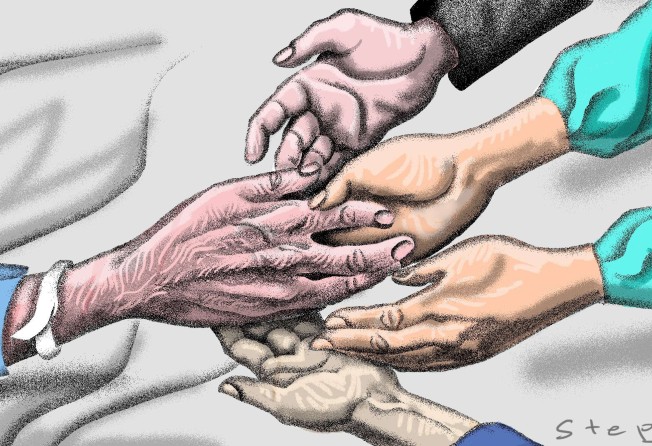
Hong Kong’s ageing population must have a bigger say in their end-of-life care
Leung Pak-yin says to meet the challenge of a population that’s living longer, with more people suffering chronic diseases, the Hospital Authority needs to change its focus


According to the latest projections, Hong Kong’s population will increase from 7.2 million in 2014 to a peak of 8.2 million in 2043, after which it will fall to around 7.8 million in 2064. Adding to this challenge is the ageing population trend. The proportion of elderly people aged 65 and above is expected to rise markedly, from 15 per cent in 2014 to 33 per cent in 2064.
In 2014, 75 per cent of elderly people were suffering from one or more chronic conditions and this figure is on a rising trend while people are living longer. It is vital for the Hospital Authority to reflect on our progress and experiences over the past 25 years, and to use the knowledge as a springboard for meeting challenges and planning for the future.
While we remain consistent in our overarching objectives, how we cope with the challenges must be under continual review to ensure we are pursuing the most effective strategies based on the social environment, our available resources and changes in medical technology and practices.
In this much changed social environment, it is no longer sufficient to focus solely on quantitative metrics such as surgical outcomes and demand on acute services.

We must take a more holistic approach to health, which includes recognising the value and importance of greater engagement with patients, their families and other stakeholders, to better understand their perceptions of “quality of life” and give them a greater say in managing their care, particularly in the last years of their life journey.
We must explore the implications of the shift from short-term cure to long-term care that is already under way. Palliative care must play an increasingly important role in enhancing the authority’s ability to handle the rise in chronic disease management, offer support and comfort to patients and their carers, and use finite resources to optimise health care effects.
The current reality, however, is that most people die in hospitals
We understand that, despite our efforts in this area, there is still a long way to go. We will soon begin formulating a strategic framework for palliative care. This will provide concrete guidance in the development of service models and system infrastructure, and for addressing the existing and anticipated gaps in the authority’s palliative care services over the next five to 10 years.
The current reality, however, is that most people die in hospitals. In 2014, there were close to 46,000 registered deaths in Hong Kong, of which about 90 per cent were in Hospital Authority facilities. Further, hospitals remain the primary focus of palliative and end-of-life care services.
With the annual number of deaths projected to rise by 50 per cent, to 69,000 by 2035, and to double to 92,000 by 2046, there is an urgent need to develop and promote alternative solutions for palliative and end-of-life care.
Palliative care coverage for cancer patients in the authority was less than 70 per cent in the 2012-13 review – a figure that sits some way below the World Health Organisation recommendation of 80 per cent. And for non-cancer patients, we have even more work to do.
We currently have about 360 palliative care beds across our network. Although in-patient capacity is not the only solution to meeting community needs over the longer term, we must take steps to address service gaps as demands on health-care services continue to evolve.

We must improve our ambulatory and outreach services, encourage closer collaboration between palliative care professionals and other health-care specialists, and provide non-medical community-based caregivers with practical support as part of an overarching goal to deliver “continuity of care”, personal choice and greater certainty to individuals with terminal or end-stage conditions.
Among elderly people who die in Hospital Authority facilities, about 40 per cent live in residential care homes. We can provide more support to these individuals by leveraging existing community infrastructure and by using training, technology and outreach initiatives to facilitate better community-based care.
A far-reaching shift in attitudes, expectations and our ability to fulfil future health-care norms will need long-term planning not only to develop and construct new infrastructure and institutions, but also to educate, encourage and inspire in all walks of life.
As part of our long-term development plans, I am grateful to the government for its support in making a HK$200 billion provision for a 10-year hospital development plan that will not only increase our service capacity but also facilitate shifts in service delivery models.
Working with the government, we shall strive to encourage the development of a more robust policy and legislative framework that facilitates advanced care and end-of-life care planning, as well as for the greater provision of palliative care outside formal hospital settings.
Dr Leung Pak-yin is chief executive of the Hospital Authority. This is an abstract from his keynote speech delivered at the opening of this year’s Hospital Authority convention